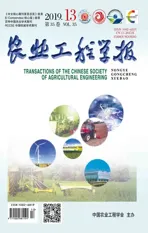太阳能干燥装置槽式复合抛物面聚光器热性能分析
2019-08-23常泽辉李建业李文龙郑宏飞
常泽辉,李建业,李文龙,侯 静,郑宏飞
太阳能干燥装置槽式复合抛物面聚光器热性能分析
常泽辉1,李建业1,李文龙1,侯 静2,郑宏飞3
(1. 内蒙古工业大学能源与动力工程学院,呼和浩特 010051;2. 内蒙古建筑职业技术学院机电与暖通工程学院,呼和浩特 010070;3. 北京理工大学机械与车辆学院,北京 100081)
直接式太阳能干燥系统在运行过程中,存在物料表面受热易硬化而阻碍其内部水分蒸发的问题,鉴于此,该文设计一种新型槽式复合抛物面聚光集热太阳能干燥系统,其由槽式复合抛物面聚光集热器、物料托盘、风机、空气管、控制系统等组成。利用光学仿真软件对系统中槽式复合抛物面聚光器进行光线追迹,计算分析不同入射偏角对聚光器光学效率、聚光效率等的影响机理。在此基础上,搭建太阳能槽式复合抛物面聚光集热干燥性能测试系统,在实际天气条件下,对聚光集热单元性能展开测试研究。结果表明,当入射光径向偏角为10°时,聚光器理论光学效率可达到70.38%,晴天太阳光正入射运行、空气流速为6.5 m/s时,接收体出口空气温度最高为37.2 ℃,比径向入射偏角为10°时提高了7.8%;加装玻璃盖板可有效提高聚光器光热转换效率,晴天时其最大转换效率为55%左右,比无玻璃盖板时最大效率提高了约120%。研究结果可为主动式太阳能聚光集热干燥系统的进一步应用提供了参考。
干燥;太阳能;效率;复合抛物面;性能
0 引 言
干燥是高耗能的单元操作[1],可以利用太阳能对烟草、茶叶、咖啡、胡椒等进行干燥,在延长农产品保存时效的同时,可以节省对化石能源的消耗。但传统露天晾晒干燥易受到天气、动物、细菌等的侵扰[2-5]。Sharma等[6]提出了直接式太阳能物料干燥器的概念[7]。但直接式太阳能干燥器在运行过程中存在物料表面由于高温硬化而阻碍其内部水分蒸发的问题[8]。为了提高太阳能干燥器的性能,尤其是缩短干燥时间、避免物料表面过热、降低投资成本等,研究学者对主动式、被动式以及混合式太阳能干燥系统展开了研究和探索[9-20]。
王伟华等[21]优化了南美白对虾太阳能干燥工艺过程,研究了太阳能干燥温度、风速和干燥量等对物料干燥能耗的影响特性,并基于试验数据进行了装置的中试。Dissa等[22]搭建了4层托盘芒果太阳能干燥器,在实际天气条件下对其进行了试验研究,建立了物料热质平衡方程式,分析了有效扩散系数、干燥速率、干燥效率等对系统性能的影响。Wafa等[23]在撒哈拉地区研究了带有储热单元的主动式太阳能干燥器,其中直接太阳能干燥室位于间接太阳能干燥室的上方,结果表明,采用直接太阳能干燥室热效率可以提高11.8%,并给出了适用于不同月份的计算模型。Hamdi等[24]采用理论分析和试验测试的方法研究了日光温室葡萄干燥系统,在测试条件下,太阳能集热器效率在29.63%~88.52%之间,可在128 h内,将葡萄的含水率降至0.22 g/g,并将试验数据与计算结果进行了比对分析。
肉孜·阿木提等[25]测试了可对太阳方位角和高度角跟踪的太阳能、电能混合干燥装置的性能,结果表明,该装置集热量可达11 964 kJ/h,与传统干燥方法相比,干燥时间缩短了52%。Ganapathy等[26]对一种由平板太阳能集热器供热的双程振荡谷物干燥器展开了研究,其每天可生产达到要求的谷物为45 kg,最高热效率为38.61%。Hao等[27]提出一种由平板太阳能集热器供能的混合式干燥器,建立了数学模型对系统热力参数展开分析,结果表明,计算结果与测试结果吻合较好,系统最大集热效率为50.8%,热损失系数在2.5~6.2 W/(K·m2)之间变化。
传统太阳能干燥系统在建造过程中需要占据大量土地资源,以提高收集的太阳热能品位。加之太阳能集热面积与散热面积相等而导致系统热利用效率不高。为了克服上述技术缺陷,太阳能聚光集热技术受到了研究人员的关注[28-29]。凌德力等[30]采用槽式聚光系统供热,实现了烟丝干燥的温度匹配,得到了气流温度、速度及入口烟丝含水率等因素对烟丝干燥特性的影响。而槽式抛物聚光集热器需要实时对日跟踪,导致太阳能干燥系统建造和维护成本高昂。鉴于此,本文设计了一种由槽式复合抛物面聚光器(compound parabolic concentrator,CPC)驱动的太阳能干燥系统,该聚光器不需要实时对日跟踪,易于对接收体进行隔热保温、同时还可以吸收部分散射光[31-32]。
本文首先利用光学仿真软件对所设计太阳能干燥系统中槽式复合抛物面聚光集热器的光学效率、聚光效率等进行模拟计算。在此基础上,搭建槽式复合抛物面聚光集热太阳能干燥性能测试系统,通过测试不同运行天气条件下聚光器试验数据,分析太阳辐照度、入射偏角及玻璃盖板等对聚光集热性能的影响,以期得到提高太阳能干燥系统热利用效率和减小占地面积的有效途径。
1 槽式复合抛物面聚光太阳能干燥系统
槽式复合抛物面聚光太阳能干燥系统主要结构参数如表1所示。
表1 太阳能干燥系统结构参数

Tab.1 Structure parameters of solar drying system
槽式复合抛物面聚光太阳能干燥系统结构如图1a所示,系统外聚光集热单元实物如图1b所示。其中,集热单元与干燥单元相分离,适合于小型分布式太阳能干燥应用。
系统采用空气强制循环换热运行,入射太阳光经槽式复合抛物面聚光器汇聚到接收体上。接收体为圆柱单层玻璃管,内置黑色平板吸收体,玻璃管内空气受热生成热空气,经热空气管进入干燥单元,在浮升力和风压作用下穿过托盘,同时对放置于上、下层托盘上的物料进行脱水干燥。增湿降温后的空气通过排气管排到系统外,补充的冷空气经位于排气管中央的冷空气管进入系统,同时吸收系统所排出空气的废热,实现冷空气的预热和对排气的回热。之后在风机驱动下进入聚光器焦斑处的接收体内,完成空气的温升。其中,干燥系统向阳的竖直墙体和屋顶均为双层保温透光玻璃板,可对干燥过程进行热量补充,其他墙面均作保温处理。
相对于传统太阳能干燥系统,槽式复合抛物面聚光太阳能干燥系统具有如下特点:1)采用复合抛物面聚光器,在相同干燥温度要求下,可以有效减少太阳能集热器数量,减少太阳能干燥系统占地面积,提高系统适用性;2)干燥系统采用主动式空气加热和被动式晾晒干燥方式相结合,提高了空气介质运行温度和循环速度,减少了干燥过程所需时间;3)集热单元散热面积仅为圆柱接收体外表面,小于集热面积,且与玻璃盖板形成温室效应,减少了系统散热损失。
2 槽式复合抛物面聚光器结构及光学仿真
将先进太阳能聚光集热技术与物料干燥技术高效耦合,既可以优化传统物料干燥工艺,又可以节省太阳能集热器占地面积。本文选择槽式复合抛物面聚光器作为太阳能集热装置,其具有低倍聚光、对跟踪精度要求低、可吸收部分散射光、反射镜面受积灰影响小以及建造成本低等特点。
2.1 复合抛物面聚光器结构
复合抛物面聚光器是由美国科学家Winston首先提出[33],为了减小聚光器对跟踪精度的要求,本文聚光器在传统复合抛物面聚光器基础上,对组成聚光器的两条抛物线和沿轴向远离轴两侧进行平移,然后绕和点向外侧旋转后截断,同时利用平面镜、和底部抛物反射面将聚光器进行闭合,其结构如图2所示。
图2中光线¢和¢分别表示正入射到组成聚光器右侧反射面上下2个边缘点的入射光线,经过聚光器后反射到圆柱接收体上,则其他入射到反射面上光线均汇聚于接收体上。光线¢表示进入聚光器入光口到底部抛物反射面上的正入射光线,经反射后汇聚于接收体上,内置黑色吸收板的圆柱玻璃接收体位于聚光器焦斑位置。为了便于后期推广应用,接收体选用市售直径为0.1 m的玻璃管,入光口玻璃盖板宽度选用0.7 m,则其几何聚光比约为2.23。

注:AB、CD为抛物反射面;BE、DF为平面镜;EOF为底部抛物反射面;AC为入光口。
2.2 光学特性及光线追迹分析
用于太阳能干燥的槽式复合抛物面聚光器应保证在工作过程中,固定放置时能够将一定入射偏角的光线汇聚到接收体上。定义入射光线与聚光器入光口对称轴之间的夹角为入射偏角,将入射偏角分解为沿径向入射偏角和轴向入射偏角,分别对应槽式复合抛物面聚光器东西放置时的太阳高度角和方位角(如图1所示)。
复合抛物面聚光器几何光学效率是指在不考虑入射光的衰减,而仅考虑由于逸出或被遮挡所造成光线损失时聚光器所具有的光学效率。将入射光线看作多条等距平行光线组成的矩阵,接收体表面的光线数量占进入聚光器入光口光线数量的比例即为几何光学效率。接收体表面能流密度占进入聚光器入光口光线能流密度的比例即为聚光效率,计算公式如下:

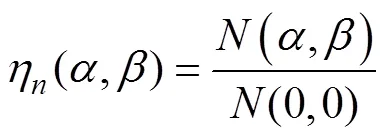
式中0为聚光器聚光效率;n为聚光器光学效率;(,) 为径向入射偏角为和轴向入射偏角为时接收体表面能流密度,W/m2;(0,0) 为正入射时进入聚光器入光口光线能流密度,W/m2;(,) 为径向入射偏角为和轴向入射偏角为时接收体表面接收到光线数量,(0,0) 为正入射时进入聚光器入光口光线数量。
利用光学仿真软件LightTools的光线追迹功能可以对聚光器几何光学效率和聚光效率进行计算。按照聚光器和接收体实物实际尺寸建模,导入到LightTools中。为了提高对聚光器光学性能的计算精度,从设定的面光源输出的光线设置为等距平行100´100光束,辐射能量为600 W/m2,与室外测试时平均太阳辐照度相近。聚光器反射面设置为镜面反射,反射率为0.8,与实物所使用的反射铝板反射率相同。正入射时,聚光器内光线追迹传播如图3a所示,进入入光口的光线经反射均被圆柱接收体所接收。当径向入射偏角为10°时,聚光器内光线追迹传播如图3b所示,入射到聚光器右侧光线经反射后部分被接收体接收,未被接收的光线经左侧反射面反射后逸出聚光器。
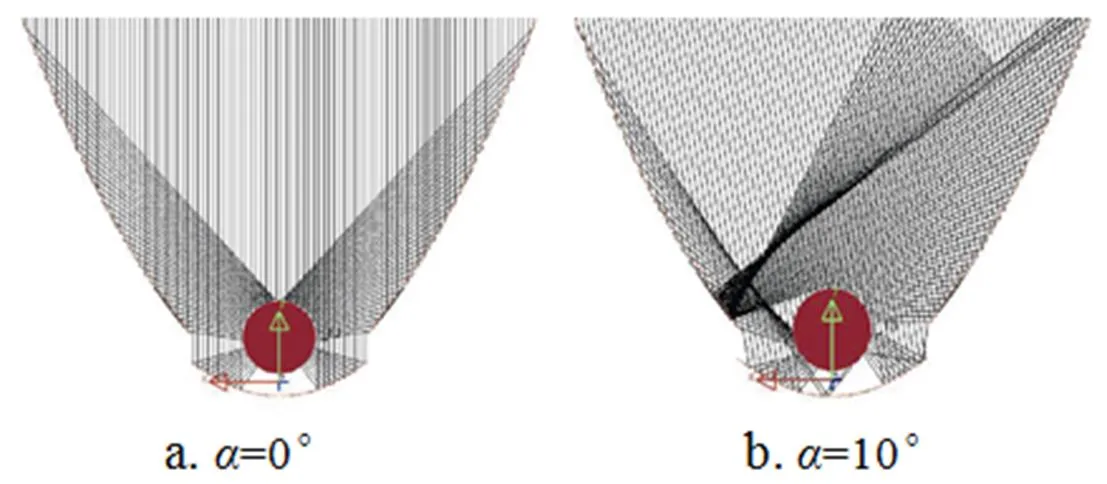
图3 复合抛物面聚光器不同入射偏角的光线追迹
2.3 仿真结果分析
2.3.1 径向入射偏角对聚光器光学性能的影响
槽式复合抛物面聚光器对入射光线聚焦能力会随着太阳的运动轨迹变化而变化,其中入射偏角也是造成聚光器光学效率和聚光效率变化的影响因素之一。对固定放置聚光器光学性能随径向入射偏角(对应太阳高度角跟踪)变化展开研究,可以获取聚光器对跟踪精度的要求。
设定光线径向入射偏角从0°~10°变化,变化间距为1°,其对聚光器光学效率和聚光效率影响如图4所示。
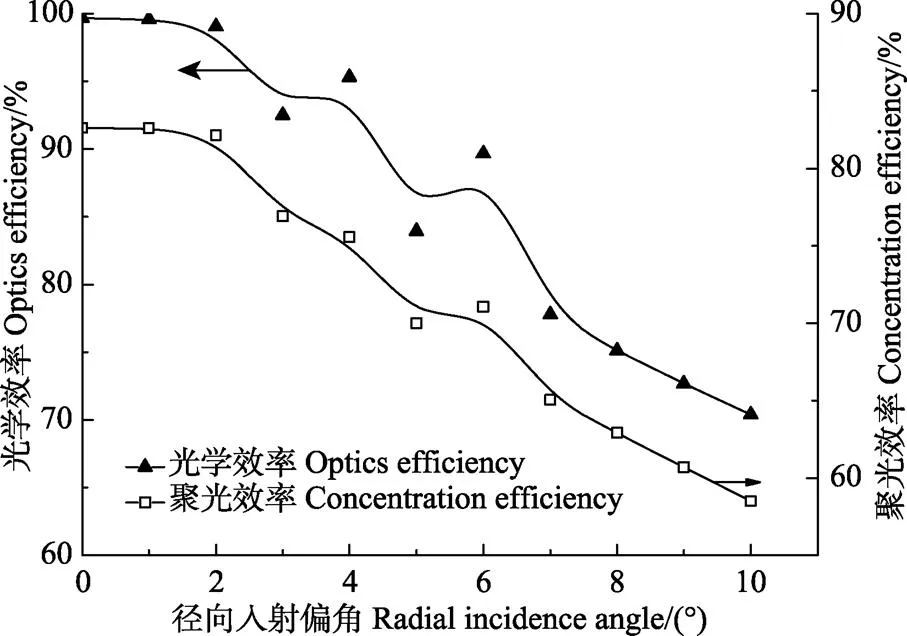
图4 径向入射偏角对聚光器性能影响
从图4可以看出,聚光器光学效率和聚光效率均随着光线径向入射偏角的增大而降低,二者变化趋势一致。光线正入射时,聚光器光学效率为99.68%,聚光效率为82.61%,比入射偏角为10°时增加41.23%。当径向入射偏角为10°时,聚光器光学效率为70.38%,聚光效率为58.49%。表明所设计的聚光器不需要实时跟踪太阳运动轨迹。
2.3.2 透光口对聚光器光学性能的影响
槽式复合抛物面聚光器属于内聚光型聚光器,接收体端头安装固定在聚光器的2个端面,为了保证聚光器的使用强度,端面一般为不透光金属板。为了提高聚光器运行时间和聚光性能,可以在聚光器端面开设透光口,研究聚光器性能随轴向入射偏角(对应太阳方位角跟踪)变化规律对于聚光器的应用具有实际意义。在聚光器端面开设高度为95 mm的透光口,则其光学效率与端面未开透光口聚光器光学效率随轴向入射偏角变化如图5所示。

图5 轴向入射偏角对聚光器性能影响
从图5中可以看出,端面有、无透光口聚光器的光学效率均随轴向入射偏角增大而直线下降。当轴向入射偏角为10°时,端面有透光口聚光器光学效率为30.7%,是端面无透光口聚光器光学效率的2.49倍,表明在端面开设透光口可以有效提高槽式复合抛物面聚光器性能。对于如何平衡端面透光口开设面积和接收体使用强度要求之间的关系还需要进一步开展研究。
3 槽式复合抛物面聚光器性能室外测试
3.1 试验测试系统
由聚光器光学仿真计算结果可知,本文中槽式复合抛物面聚光器在提高接收体能流密度的同时,不需要实时对日跟踪,这是其他类型太阳能聚光集热装置所无法实现的。为了验证光学理论计算结果,在实际天气条件下,对槽式复合抛物面聚光器在太阳能干燥系统中的实用性进行测试及分析。
测试系统中的槽式复合抛物面聚光器为自制,两侧端面开有透光口,入光口覆盖超白钢化玻璃,围护采用反射铝板,反射率为0.8,长度为2.0 m,其他参数与光学仿真模型完全一致。为防止过热且考虑到系统建造成本,接收体选用内置有黑色吸收板的单层玻璃管,直径为0.1 m,长度为2.2 m,玻璃透光率>0.9。
测试中,主要研究天气条件、入射偏角、玻璃盖板等对聚光器性能的影响。在玻璃管接收体进、出口处沿径向等距布置3个K型热电偶,取其平均值作为循环空气在接收体内进、出口温度值,测试值由多通道温度记录仪(Sin-R6000C,杭州联测自动化技术有限公司,杭州)实时监测,空气流速由热线式风速计(TES-1340,泰仕电子工业有限公司,台湾)测量,系统中风机选用耐高温离心风机(DZ160,广州市鑫风风机有限公司,广州),环境温度、太阳辐照度以及环境风速由太阳能发电监测站系统(TRM-FD1,锦州阳光气象科技有限公司,锦州)实时监测,测温用热电偶测试精度为±0.5 ℃。
试验中,槽式复合抛物面聚光器在运行过程中瞬时光热转换效率可由下式计算:

式中Q为玻璃管接收体集热量,W;sun为聚光器入光口处太阳辐照度,W/m2;为聚光器入光口面积,m2;为接收体内空气质量流量,kg/s;c为对应加热温度下空气比热容,J/kg·K;in,out为接收体进出口空气温度值,K。
测试前,对所使用的热线式风速计、总辐射表、K型热电偶、风速计等仪器进行了测试校核。测试地点选在内蒙古呼和浩特市南郊(N40°50¢,E111°42¢),测试时间为2018年10月6日-2018年10月20日,空气流速为6.5 m/s。
为了与光学理论分析结果进行对比,对径向入射偏角与聚光器性能的关联进行分析,尽量避免轴向入射偏角的影响,测试时间选择在中午11:00-12:30,而此时间段对于内蒙古呼和浩特地区正是太阳光正入射聚光器的有效时间范围,所以本文选择此时间段进行试验测试。
3.2 测试结果与分析
3.2.1 天气条件、入射偏角对聚光器性能影响
测试时,采用对比分析法对2组相同槽式复合抛物面聚光器在不同天气、不同入射偏角条件下接收体出口空气温度进行分析。测试日分别选择多云天(2018年10月14日)和晴天(2018年10月16日),2组聚光器均东西放置,吸收板与正午太阳入射光平行。一组聚光器接收正入射(即径向入射偏角为0°)太阳光,另一组聚光器的径向入射偏角为10°,天气条件及2组聚光器内接收体出口空气温度随时间变化曲线如图6,图7所示。
从图6、图7可以看出,在晴天或多云天运行中,正入射时玻璃管接收体出口空气温度大于入射偏角为10°时接收体出口空气温度。多云天时,接收体出口空气温度要小于晴天时接收体出口空气温度,这主要是由于多云天太阳直接辐射值小于晴天太阳直接辐射值。晴天正入射时接收体最大出口空气温度为37.2 ℃,比入射偏角为10°时接收体对应出口空气温度提高7.8%。正午时分入射偏角为0°时,玻璃管接收体平均集热量为445.73 W,比入射偏角为10°时增加了42.57%,与光学仿真计算结果相差3.3%。多云天气条件下,接收体出口空气温度变化曲线表明该类型聚光器可以接受部分散射光。

图6 测试时的太阳辐照度和环境温度

图7 接收体出口温度随入射偏角变化
3.2.2 玻璃盖板对聚光器性能影响
槽式复合抛物面聚光器入光口处超白钢化玻璃盖板具有保护反射面受到灰尘污染、与聚光器围护共同起到“温室”作用、保护玻璃管接收体免受损坏等功能。其中玻璃盖板对聚光器光热转换效率、循环空气温升的影响需要通过测试加以分析。
选取2组相同规格聚光器,在晴天太阳光入射条件下,对比研究有、无玻璃盖板对聚光器性能的影响。有无玻璃盖板聚光器接收体进、出口空气温度随太阳辐照度变化如图8所示。
图8表明,对于2组测试聚光器,接收体进、出口空气温度变化趋势与太阳辐照度变化趋势相一致。有玻璃盖板聚光器出口空气温度最大为33.2 ℃,无玻璃盖板聚光器出口空气温度最大为25.6 ℃。究其原因,玻璃盖板的安装,使聚光器形成密封空间,在太阳照射下,产生“温室”效应,有效对单层玻璃管接收体进行了隔热保温,而无玻璃盖板聚光器中的单层玻璃管接收体受到周围环境温度、风速的影响较大,散热损失较大。在测试中,玻璃盖板对于消除聚光器结霜影响也有益处。2组聚光器光热转换效率计算对比如图9所示。
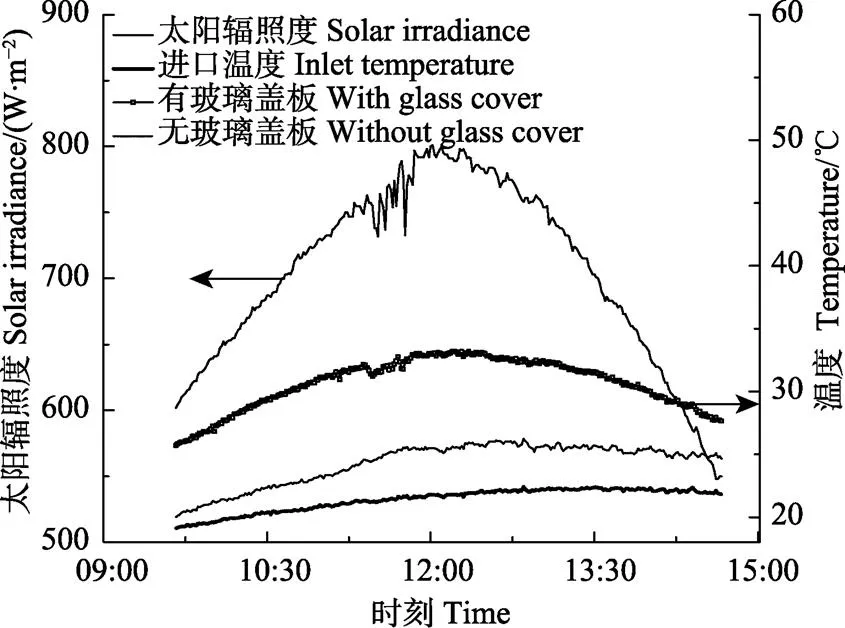
图8 接收体进出口温差随太阳辐照度变化
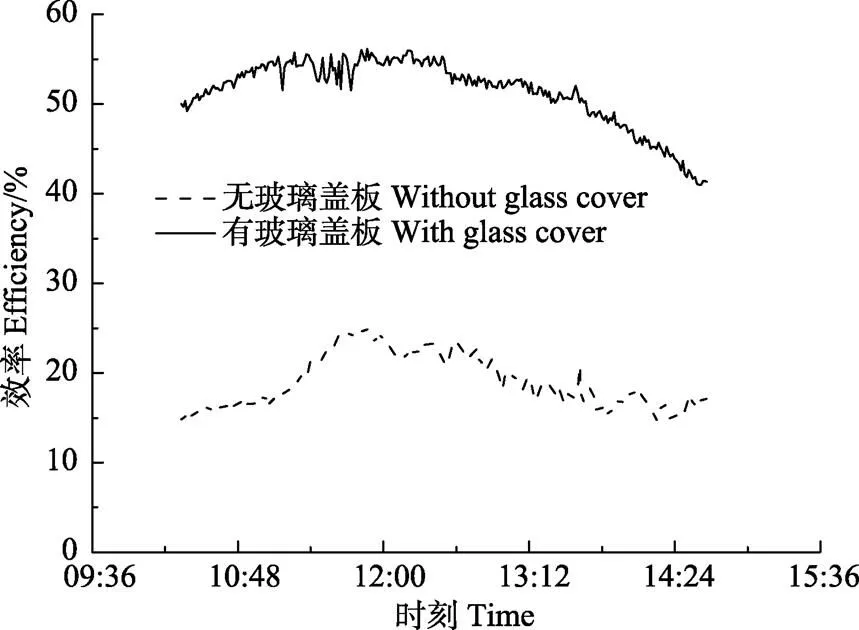
图9 聚光器效率随时间变化
从图9中可以看出,由于聚光器加装玻璃盖板,其最大光热转换效率可以达到55%左右,比无玻璃盖板聚光器增加了120%,测试周期内平均光热转换效率为51.35%。无玻璃盖板聚光器的最大光热转换效率约为25%,测试周期内平均光热转换效率为19.09%。通过在聚光器入光口加装玻璃盖板可以有效提高装置光热转换效率,同时还可以用单层玻璃管代替昂贵的玻璃真空管作为接收体,具有较好经济性。
4 结 论
为了减小太阳能干燥系统集热器占地面积、提高太阳能光热转化效率,本文设计一种槽式复合抛物面聚光集热太阳能干燥系统,利用光学仿真软件对槽式复合抛物面聚光器聚光性能进行了理论计算分析,在此基础上,测试研究了实际天气条件下,不同入射偏角、有无玻璃盖板等对槽式复合抛物面聚光器温升、光热转化效率等的影响。得到以下结论:
1)光学仿真计算结果表明,当入射偏角为10°时,本文所设计的聚光器的光学效率仍可以达到70.38%。
2)对于复合抛物面聚光器等内聚光式聚光器,在两侧端面开设透光口可以有效提高聚光器的光学效率。
3)在晴天运行,空气流速为6.5 m/s时,太阳正入射聚光器接收体出口空气温度最高为37.2 ℃,比入射偏角为10°时提高7.8%。接收体集热量为445.73 W,比入射偏角为10°时集热量增加了42.57%,与光学仿真计算结果相近。
4)通过在槽式复合抛物面聚光器入光口加装玻璃盖板可以有效提高光热转化效率,最大效率约为55%,比相同运行条件下无玻璃盖板聚光器效率提高120%。
[1] 李长友. 粮食干燥传递和转换特征及其理论表达[J]. 农业工程学报,2018,34(19):1-8. Li Changyou. Theoreticalanalysis of exergy transfer and conversion in grain drying process[J]. Transactions of the Chinese Society of Agricultural Engineering (Transactions of the CSAE), 2018, 34(19): 1-8. (in Chinese with English abstract)
[2] Fudholi A, Sopian K, Ruslan M H, et al. Review of solar dryers for agricultural and marine products[J]. Renewable & Sustainable Energy Reviews, 2010, 14(1): 1-30.
[3] Abdulmalek S H, Assadi M K, Al-Kayiem H H,et al. A comparative analysis on the uniformity enhancement methods of solar thermal drying[J]. Energy, 2018, 148: 1103-1105.
[4] El-Sebaii A A, Shalaby S M. Solar drying of agricultural products: A review[J]. Renewable and Sustainable Energy Reviews, 2012, 16(1): 37-43.
[5] 李伟钊,盛伟,张振涛,等. 热管联合多级串联热泵玉米干燥系统性能试验[J]. 农业工程学报,2018,34(4):278-284. Li Weizhao, Sheng Wei, Zhang Zhentao, et al. Experiment on performance of corn drying system with combination of heat pipe and multi-stage series heat pump equipment[J]. Transactions of the Chinese Society of Agricultural Engineering (Transactions of the CSAE), 2018, 34(4): 278-284. (in Chinese with English abstract)
[6] Sharma A, Chen C R, Vu L N. Solar-energy drying systems: A review[J]. Renewable and Sustainable Energy Reviews, 2009, 13: 1185-1210.
[7] Belessiotis V, Delyannis E. Solar drying[J]. Solar Energy, 2011, 85(8): 1665-1691.
[8] Pirasteh G, Saidur R, Rahman S M A, et al. A review on development of solar drying applications[J]. Renewable and Sustainable Energy Reviews, 2014, 31: 133-48.
[9] Mahesh K, Sunil K S, Pankaj K. Progress in solar dryers for drying various commodities[J]. Renewable & Sustainable Energy Reviews, 2016, 55: 346-360.
[10] Tomar V, Tiwari G N, Norton B. Solar dryers for tropical food preservation: Thermophysics of crops, systems and components[J]. Solar Energy, 2017, 154: 2-13.
[11] Bal L M, Satya S, Naik S N. Solar dryer with thermal energy storage systems for drying agricultural food products: A review[J]. Renewable & Sustainable Energy Reviews, 2010, 14: 2298-2314.
[12] Aymen K E, Salwa B, Sami Kooli, et al. Thermal behavior of indirect solar dryer: Nocturnal usage of solar air collector with PCM[J]. Journal of Cleaner Production, 2017, 148: 37-48.
[13] Kant K, Shukla A, Sharma A, et al. Thermal energy storage based solar drying systems: A review[J]. Innovative Food Science & Emerging Technologies, 2016, 34: 86-99.
[14] Mohamed E A , Mostafa A M , Abdulrahman O A. Energy analysis of hybrid solar tunnel dryer with PV system and solar collector for drying mint (MenthaViridis)[J]. Journal of Cleaner Production, 2018, 181: 352-364.
[15] Ehsan B, Saeed R, Omid B. Experimental investigation of the performance of a mixed-mode solar dryer with thermal energy storage[J]. Renewable Energy, 2017, 112: 143-150.
[16] Chandrasekar M, Senthilkumar T, Kumaragurubaran B, et al. Experimental investigation on a solar dryer integrated with condenser unit of split air conditioner (A/C) for enhancing drying rate[J]. Renewable Energy, 2018, 122: 375-381.
[17] Amer B M A, Gottschalk K, Hossain M A. Integrated hybrid solar drying system and its drying kinetics of chamomile[J]. Renewable Energy, 2018, 121: 539-547.
[18] Tiwari S, Tiwari G N, Al-helal I M, et al. Development and recent trends in greenhouse dryer: A review[J]. Renewable and Sustainable Energy Reviews, 2016, 65: 1048-1064.
[19] Aaineb Z, Sami Kooli, Aymen E, et al. Investigation of a new solar greenhouse drying system for peppers[J]. International Journal of Hydrogen Energy, 2017, 42: 8818-8826.
[20] Pushpendra S, Vipin S, Anil K. Developments in greenhouse solar drying: A review[J]. Renewable and Sustainable Energy Reviews, 2018, 82: 3250-3262.
[21] 王伟华,王海,何思鲁,等. 南美白对虾太阳能干燥能耗参数优化及中试[J]. 农业工程学报,2016,32(18):271-278. Wang Weihua, Wang Hai, He Silu, et al. Parameter optimization for energy consumption of solar drying ofand pilot scale rest[J]. Transactions of the Chinese Society of Agricultural Engineering (Transactions of the CSAE), 2016, 32(18): 271-278. (in Chinese with English abstract)
[22] Dissa A O, Bathiebo D J, Desmorieux H, et al. Experimental characterisation and modelling of thin layer direct solar drying of Amelie and Brooks mangoes[J]. Energy, 2011, 36: 2517-2527.
[23] Wafa B C, Abdellah K, Ahmed M, et al. Experimental investigation of an active direct and indirect solar dryer with sensible heat storage for camel meat drying in Saharan environment[J]. Solar Energy, 2018, 174: 328-341.
[24] Hamdi I, Kooli S, Elkhadraoui A, et al. Experimental study and numerical modeling for drying grapes under solar greenhouse[J]. Renewable Energy, 2018, 127: 936-946.
[25] 肉孜·阿木提,毛志怀,李峰,等. 整体式果品蔬菜太阳能干燥装置设计与试验[J]. 农业机械学报,2011,42(1):134-139.Rouzi·Amuti, Mao Zhihuai, Li Feng, et al. Design and experiment of integrative fruit-vegetable air dryer[J]. Transactions of the Chinese Society for Agricultural Machinery, 2011, 42(1): 134-139. (in Chinese with English abstract)
[26] Ganapathy P A, Subramaniam S, Arunachalam V, et al. Performance analysis of double-pass oscillating bed solar dryer for drying of non-parboiled paddy grains[J]. Energy Sources, 2019, 41(4): 418-426.
[27] Hao W G, Lu y f, Lai Y H, et al. Research on operation strategy and performance prediction of flat plate solar collector with dual-function for drying agricultural products[J]. Renewable Energy, 2018, 127: 685-696.
[28] Sharma A, Chen C R, Lan N V . Solar-energy drying systems: A review[J]. Renewable & Sustainable Energy Reviews, 2009, 13(6): 1185-1210.
[29] Geng W G, Gao L, Ma X X, et al. Honeysuckle drying by using hybrid concentrator photovoltaic-thermal (PV/T) dryer: An experimental study[J]. Applied Mechanics and Materials, 2013, 291: 132-136.
[30] 凌德力,李明,罗熙,等. 基于槽式聚光太阳能供热的烟丝干燥特性研究[J]. 太阳能学报,2015,36(2):460-466. Ling Deli, Li Ming, Luo Xi, et al. Study on drying characteristics of cut tobacco based on trough concentrating solar heating[J]. Acta Energiae Solaris Sinica, 2015, 36(2): 460-466. (in Chinese with English abstract)
[31] Tian M, Su Y H, Zheng H F, et al. A review on the recent research progress in the compound parabolic concentrator for solar energy application [J]. Renewable & Sustainable Energy Reviews, 2018, 82: 1272-1296.
[32] Srikanth M, Robert F B. A review of nonimaging solar concentrators for stationary and passive tracking applications[J]. Renewable & Sustainable Energy Reviews, 2017, 71: 309-322.
[33] Winston R. Solar concentrators of novel design[J]. Solar Energy, 1974, 61: 89-95.
Analysis on thermal performance of trough compound parabolic concentrator in solar drying device
Chang Zehui1, Li Jianye1, Li Wenlong1, Hou Jing2, Zheng Hongfei3
(1.010051,; 2.010070,; 3.,,100081,)
Drying is an energy intensive process, which reduces the moisture content of the material to a certain preselected level to prevent deterioration. The increasing of agro-food products’ cost and the rapid depletion of fossil fuels accelerated the utilization of solar energy for drying. However, conventional open cycle solar drying system has several disadvantages, including the degradation of product quality caused by sudden rain, wind and dust, loss of the products due to rodents, birds and insects. To overcome these disadvantages and ensure better control of solar drying aspects, the direct solar drying systems have been designed and improved over decades. It has been noted that direct exposure to the sun during sunny day, particularly when the ambient temperature reaches to 30 ℃ or higher, might cause case hardening, which trapping moisture inside the products scattered. Based on the previous researches, this paper therefore designs a novel concentrated solar drying system. In this case, a trough compound parabolic concentrator (CPC) as heater is employed for solar-energy collection for heating of inlet air. Apart from this, the system is also configured with several trays, fan, operation air tube, control device, et al. Compared with the previous solar drying system, it not only improves the thermal efficiency of the system but also reduces the land area of the solar collectors. The system is suitable for use distributed and controllable for drying process. Its operation principle of the system can be shown as follows: Several concentrators installed with glass receiver are connected with air tubes. Then in the receiver, a plate heat transfer fin is spread by a black composite material coating to increase the sun absorptivity. The thickness of the fin is 1.5 mm. The air inside the receiver is heated to a higher temperature by the concentrated light. The heated air flows into the drying unit through the hot air pipe driven by fan. Then the flowing hot air passes through the materials placed on the trays. The materials will be heated and moisture will be removed. As the air driven by the fan flows towards exhaust pipe, the waste heat contained in the air in the exhaust pipe will transfer to the supplementary air in the cold air tube, which improves the system energy efficiency. The working principle of the trough compound parabolic concentrator and structure are introduced. A 3D model of the concentrator is obtained in commercial software SolidWorks, then is exported in IGES digital format so that it could be imported to optical analysis software to analyze ray tracing. The concentrating efficiency and optical efficiency of the concentrator have been calculated and analyzed. Based on the simulated results mentioned above, an experimental system driven by several trough compound parabolic concentrators is constructed to study the drying performance of the system outdoors. The geometric parameters of the concentrator unit are the same as the unit previously discussed. The results indicate when the radial incidence angle is 10°, the optical efficiency can reach to 70.38%. The light window is set in the sides of the concentrator has benefit to enhancement of the optical efficiency when axial incidence angle is not 0°. In sunny day, the maximum air temperature of the outlet can be reached to 37.2 ℃, which is higher than that of the unit when radial incidence angle is 10° by 7.8% when the air flow rate is 6.5m/s. A glass cover is placed on concentrator aperture to minimize convective heat losses from the receiver. The maximum thermal efficiency of the device with glass cover can be about 55%, which is higher than that of the concentrator without glass cover by about 120%. Thus, this study is able to provide theoretical and experimental reference for further application for active solar drying technology.
drying; solar energy; efficiency; compound parabolic; performance
10.11975/j.issn.1002-6819.2019.13.023
TK519
A
1002-6819(2019)-13-0197-07
2019-02-20
2019-04-09
国家自然科学基金项目(51666013);内蒙古自治区科技重大专项(2018);内蒙古自治区高等学校科学研究项目(NJZY17491);内蒙古自治区高校青年科技英才支持计划;内蒙古自治区研究生科研创新项目(S2018111948Z)
常泽辉,教授,博士生导师,主要从事太阳能光热利用技术研究。Email:changzehui@163.com
常泽辉,李建业,李文龙,侯 静,郑宏飞.太阳能干燥装置槽式复合抛物面聚光器热性能分析[J]. 农业工程学报,2019,35(13):197-203. doi:10.11975/j.issn.1002-6819.2019.13.023 http://www.tcsae.org
Chang Zehui, Li Jianye, Li Wenlong, Hou Jing, Zheng Hongfei.Analysis on thermal performance of trough compound parabolic concentrator in solar drying device[J]. Transactions of the Chinese Society of Agricultural Engineering (Transactions of the CSAE), 2019, 35(13): 197-203. (in Chinese with English abstract) doi:10.11975/j.issn.1002-6819.2019.13.023 http://www.tcsae.org
